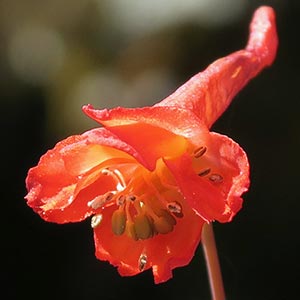Delphinium nudicaule
Delphinium bakeri
canyon delphinium, canyon larkspur, orange larkspur, red larkspur, red or orange larkspur, scarlet larkspur
Baker's delphinium, Baker's larkspur
(15-)20-50(-125) cm;
base reddish, glabrous.
(45-)60-85(-100) cm;
base reddish, glabrous.
blade round to pentagonal, 2-6 × 3-10 cm; ultimate lobes 3-12, width 5-40 mm (basal), 2-20 mm (cauline).
blade pentagonal to round, 1-6 × 1.5-8 cm, margins crenate, glabrous; ultimate lobes 3-5, width 2-5 mm (basal), 5-30 mm (cauline), widest at middle or in proximal 1/2.
5-20(-69)-flowered;
pedicel (1.5-)2-6(-8) cm, glabrous to glandular-pubescent;
bracteoles 14-20(-30) mm from flowers, green to red, linear, 2-4(-9) mm, glabrous to puberulent.
8-23-flowered, at least 2 times longer than wide;
pedicel 1-6(-9) cm, glandular-puberulent;
bracteoles 4-6 mm from flowers, green to blue, lance-linear, 5-8(-13) mm, glabrous to glandular-puberulent.
sepals scarlet to reddish orange, rarely dull yellow, glabrous, lateral sepals forward-pointing to form pseudotube, (6-)8-13(-16) × 3-6 mm, spurs straight, slightly ascending, (12-)18-27(-34) mm;
lower petal blades elevated, exposing stamens, 2-3 mm, clefts 0.5-1 mm;
hairs sparse, evenly dispersed, yellow.
sepals dark bluish purple, nearly glabrous, lateral sepals spreading, 9-11 × 4-5 mm, spur apex decurved, ± horizontal, 9-13 mm;
lower petal blades ± covering stamens, 5-7 mm, clefts 2-3 mm;
hairs sparse, mostly near base of cleft, centered or on inner lobes, white.
13-26 mm, 3.5-4.5 times longer than wide, glabrous.
18-20 mm, 3.5-4 times longer than wide, glabrous.
unwinged or sometimes slightly wing-margined;
seed coat cells with surfaces smooth.
unwinged;
seed coats smooth.
= 16.
Delphinium nudicaule
Delphinium bakeri
Delphinium nudicaule hybridizes with most other taxa of Delphinium that it encounters. Apparent hybrids involving D. nudicaule, and seen by the author (either afield or as specimens), include D. andersonii, D. antoninum, D. decorum, D. luteum, D. nuttallianum, D. patens, and D. trolliifolium. In addition, garden-grown plants have been hybridized with D. cardinale, D. elatum, D. menziesii, D. parishii, D. penardii, D. tatsienense Franchet, D. triste Fischer ex de Candolle, and D. uliginosum; D. nudicaule does not naturally occur with these species. Delphinium nudicaule is one of the earliest larkspurs to flower in any given locality. Douglas's type collection of D. nudicaule represents plants (synonyms D. sarcophyllum Hooker & Arnott and D. peltatum Hooker, an invalid name) grown under very moist conditions, probably quite near the ocean. The type specimen of D. armeniacum A. Heller represents plants grown under unusually dry conditions.
The Mendocino Indians consider Delphinium nudicaule a narcotic (D. E. Moerman 1986).
(Discussion copyrighted by Flora of North America; reprinted with permission.)
Of conservation concern.
Delphinium bakeri is possibly extinct in the wild because of cultivation and sheep grazing in the small area where it grows. It is known from only two localities and has not been collected since 1960. Plants have been grown at Strybing Arboretum, Golden Gate Park, San Francisco. Although their geographic ranges are distinct, D. bakeri is most similar to, and probably closely related to, D. trolliifolium. The former has more rounded incisions on the leaves than the latter, and the pedicel of D. bakeri are consistently glandular. Glandular pedicel appear only occasionally in D. trolliifolium.
(Discussion copyrighted by Flora of North America; reprinted with permission.)


